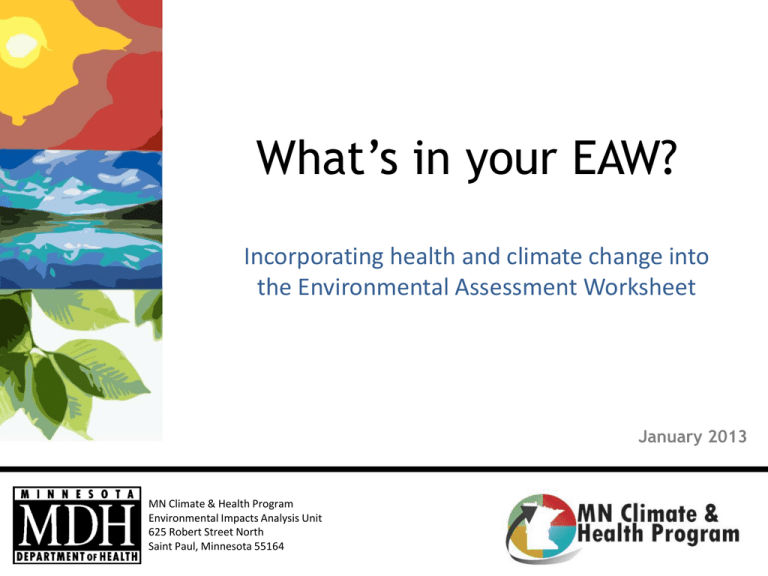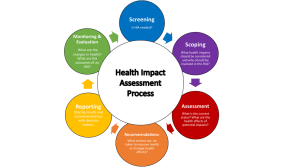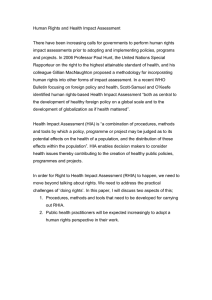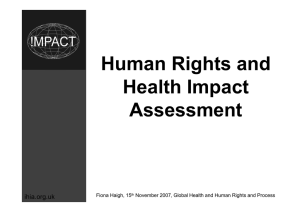
What’s in your EAW?
Incorporating health and climate change into
the Environmental Assessment Worksheet
January 2013
MN Climate & Health Program
Environmental Impacts Analysis Unit
625 Robert Street North
Saint Paul, Minnesota 55164
Overview
Introduction to environmental review in MN
How the built environment relates to health
and climate change
Addressing health and climate change in the
EAW
Recommendations
Item-specific guidance
Health impact assessments (HIA)
Alaska case study
California case study
INTRODUCTION TO ENVIRONMENTAL
REVIEW IN MINNESOTA
The slides in the following section are provided by Bob Patton,
Executive Director of the Environmental Quality Board
Minnesota Environmental Policy Act
(Minnesota Statutes Ch. 116D)
“It is the continuing policy of the state
government . . . to create and maintain
conditions under which human beings and nature
can exist in productive harmony, and fulfill the
social, economic, and other requirements of
present and future generations”
Environmental Review
Applies to projects that “may have
potential for significant environmental
effects”
Intended to disclose information through
a systematic, public process
Works in conjunction with permits and
other approvals
Program Elements
Mandatory Categories and Exemptions
Environmental Assessment Worksheet
(EAW)
Citizens Petition for an EAW
Environmental Impact Statement (EIS)
AUAR, GEIS and other alternative forms
of review
RGUs
* Office of the Legislative Auditor, analysis of EQB Monitor, 7/3/2006 through
7/12/2010
EAWs and EISs
Environmental Assessment Worksheet
“…a brief document which is designed to set out the basic facts necessary to determine whether an EIS is
required…”
Decision on Need for EIS
“An EIS shall be ordered for projects that have
the potential for significant environmental effects”
Environmental Impact Statement
“…a detailed written statement…”
Environmental Quality Board
Governor’s representative
Nine Agency Commissioners
Administration
Agriculture
Commerce
Employment & Economic Development
Health
Natural Resources
Pollution Control
Transportation
Water & Soil Resources
Five Citizen Members
HOW THE BUILT ENVIRONMENT
RELATES TO CLIMATE CHANGE AND
HEALTH
The built environment, health and
climate change
Example #1: Potential health
outcomes of auto-oriented
development
- Obesity,
diabetes
-More
driving
(VMT)
Auto-oriented
development
-Loss of
natural
environment
- Loss of crop
land
- Premature
deaths
- Less walking
- Asthma
- Severe
storms
- More air
pollution/ GHG
emissions
- Climate
change
- Extreme
heat
- Less access to
healthy foods
- Food
insecurity
- Reduced
water quality
and quantity
The built environment, health and
climate change
Example #2: Effects of
climate change on the
built environment and
health
Contamination
of surface and
groundwater
- Stormwater
overflow
- Frequent
flooding
(climate
change)
- Damage to
property and
infrastructure
- Injuries and
deaths
- Mold and
fungus
- Water-borne
and foodborne
illnesses
- Allergies
ADDRESSING HEALTH AND CLIMATE
CHANGE IN STATE LEVEL
ENVIRONMENTAL REVIEW
Addressing health and climate
change in environmental review
Some health and climate change issues are already
addressed in many states’ environmental review:
Air quality (including odor and air pollution
emissions)
Noise
Hazardous activities or waste
Aesthetics and scenic vistas
Active transit and recreational resources
Economic and cultural welfare
Climate change issues related to GHGs
Addressing health and climate
change in environmental review
Common examples of health language:
Does the proposed project . . .
“expose people to potential substantial adverse
effects/a significant risk” or
“create hazards to human health and safety”
Climate change language: refers to the
generation and mitigation of GHG emissions
and requires the RGU to comply with existing
climate change or GHG emission policies
Unique inclusions of health
California addresses
the displacement of
existing housing and
people due to the
development of a
new project
Unique inclusions of health
Massachusetts: “How will
the project implement
and/or promote the use
of transit, pedestrian
and bicycle facilities and
services to provide
access to and from the
project site?”
Unique inclusions of health
New York State includes
a section specifically
called “Impact on Public
Health,” which asks
“will proposed action
affect public health and
safety?”
Addressing health and climate
change in MN’s EAW
Minnesota EAW gaps:
Food availability (farm land impacts and
accessibility to stores/farmers markets/etc.)
Housing
Urban heat island effect
Connectivity of recreation facilities and multimodal trails related to activity and obesity levels
Pedestrian/vehicular safety
Response times for emergency services
Cumulative effects (e.g., the need for new
public facilities, such as schools, fire, and
police)
Issue: defining ‘environment’
EQB rules define “environment” to
include: “land, air, water, minerals,
flora, fauna, ambient noise, energy
resources, and man-made objects or
natural features of historic, geologic or
aesthetic significance (part 4410.0200,
subpart 23).”
Issue: defining ‘environment’
EAW can only analyze direct impacts
Direct impact (OK): contaminated ground
water from construction
Indirect impact (Not OK): vehicle-related
injuries because of additional car and truck
traffic
RECOMMENDATIONS
Recommendations – Part I
Item-specific guidance
Issue
MDH Recommendation
How to assess
Resources
Safety - Issue
Co-existence of multiple
modes of transportation
can increase risk of
accidents without inclusion
of appropriate safety
measures
Safety - Recommendation
Traffic:
1. Address intersections or streets where
pedestrian (or bicycle or vehicular)
injury/collisions have occurred
2. Or identify where potential conflicts may occur
after construction
3. Provide any measures the project is planning to
mitigate these conflicts
Consider availability of transit and/or other
alternative transportation modes
Safety - Assessment
If building a road, use
complete streets,
traffic calming, access
management site
design or off-site
mitigation
Photo credit: Ann Forsyth
University of Minnesota, Design for Health
We want this . . .
Photo credit: Ann Forsyth
University of Minnesota, Design for Health
Not this . . .
Safety - Resources
National/MN Complete Streets Coalition
www.smartgrowthamerica.org/complete-streets
www.mncompletestreets.org
MnDOT Complete Streets
www.dot.state.mn.us/planning/completestreets/
MnDOT Safe Routes to School
www.dot.state.mn.us/saferoutes/
MDH Safe Routes to School
www.health.state.mn.us/divs/oshii/srts/
Land use - Issue
Land use conflicts
Industry and manufacturing
activities (e.g., fertilizers,
pesticides, textiles and leather
goods)
Health risks to nearby
populations, for example
Proximity to hazardous waste
landfill sites increases risk of:
cancer, skin irritation, low birth
weight, birth defects, fatigue,
sleepiness, and headaches
Land use - Recommendation
Land Use:
Classify existing land uses
Assess community plans for
future land use as directed by
plans and zoning
Identify potential
incompatibility between the
existing land use, plans or
zoning, and proposed project
Mitigate any incompatibilities
that could harm health
Land use map
Source: City of Minneapolis
Land Use - Assessment
Review local zoning, including overlay
districts
If project requires zoning change, or
conditional use permit, consider
appropriate siting, including:
Buffer (vegetative or set back) from
incompatible uses
Concentrate the most noxious operations of
the project as far from incompatible uses as
possible
Land Use - Assessment
In addition to environmental
contaminants, consider broader
impact of existing land use and
proposed project on neighborhood:
Effect on property values
Removal of existing
greenspace
Potential addition of
new community asset
Land Use - Resources
Leading Change for Healthy Communities
and Successful Land Reuse, ATSDR
http://www.atsdr.cdc.gov/sites/brownfields/pu
blications.html
Sustainable Sites Initiative Guidelines and
Performance Benchmarks
http://www.sustainablesites.org/products/
Design for Health, Environment and Housing
Quality
http://designforhealth.net/general-healthissues/environment-and-housing-quality/
Affordable housing & mixed-use
development - Issue
Unaffordable housing affects
health by
Reducing the resources
available for nutritious food
and necessary health care
expenses
Causing stress, residential
instability, and crowding
Affordable housing & mixed-use
development - Issue
Walkable, mixed use
communities preserve
environmental resources
and promote health by
concentrating developing
reducing car use and tailpipe
emissions
encouraging physical activity
promoting access to retail
and services
Photo credit: Ann Forsyth
University of Minnesota, Design for Health
Affordable housing & mixed-use
development - Recommendation
If the project proposes the demolition,
removal or remodeling of housing and
especially affordable housing, it should
discuss how it plans to support the
replacement of the housing
Affordable housing & mixed-use
development - Recommendation
Support clustering development as a best
practice
Source: MPCA Stormwater Best Management Practices Manual, Chapter 3
Affordable housing & mixed-use
development - Assessment
Determine whether project proposes to
remove existing housing that is affordable
to persons making less than or equal to
the median area household income
Identify natural resources (e.g.,
wetlands, forest and agriculture) and
cluster development to preserve these
resources
Affordable housing & mixed-use
development - Resources
National Center for Healthy Housing:
http://changelabsolutions.org/sites/changelabsolutions.org/files/He
alth%20%20Housing%20New%20Opportunities_final.pdf
Anticipated Effects of Residential Displacement on Health: Results
from Qualitative Research
http://www.sfphes.org/component/jdownloads/viewcategory/6housing?Itemid=62
UMN Extension: Residential Cluster Development
http://www.extension.umn.edu/distribution/naturalresources/DD705
9.html
A Framework for Understanding Conservation Development and Its
Ecological Implications
http://s3.amazonaws.com/conservationtools/s3_files/544/A_Framew
ork_for_Understanding_Conservation_Development.pdf?AWSAccessKey
Id=1NXAG53SXSSG82H0V902&Expires=1342705700&Signature=QAUx%2B
6%2B79aCEuQl0byHYxAf6q94%3D
Climate change - Issue
Increased formation of ozone and
respiratory issues
Frequency and intensity of
extreme heat events, severe
storms, floods, drought, wildfires
Impacts on heat-related
illness/death, safety
(injury/death from flood or
wildfire), damage to property,
damage to crops, food insecurity
Climate change - Recommendation
Make the connection to climate change
Projects should describe any efforts being taken
to mitigate emissions or adapt to the potential
impacts of climate change
For example, if the project is an infill
development and proposes to increase the tree
canopy – this would be a mitigation effort to
reduce GHG as well as an adaption measure to
increase infiltration to manage stormwater and
reduce the urban heat island effect, especially
during extreme heat events.
Climate Change - Assessment
Assess how the project will be
affected by climate change
Flooding (infiltration)
Urban heat island (tree canopy)
Power outages (on-site generator)
Assess how the project can
mitigate greenhouse gases:
Green/white roofs
Energy efficient buildings
Climate Change - Resources
MPCA, Climate Change: Air Permits and
Environmental Review
http://www.pca.state.mn.us/index.php/topics/clim
ate-change/regulatory-initiatives-programs-andpolicies/climate-change-air-permits-andenvironmental-review.html
Sustainable Sites Initiative Guidelines and
Performance Benchmarks
http://www.sustainablesites.org/products/
Design for Health, Climate Change
http://designforhealth.net/general-healthissues/climate-change/
Stormwater - Issue
Stormwater runoff picks up and carries with it
many different pollutants that are found on
paved surfaces such as
sediment, nitrogen,
phosphorus, bacteria,
oil, grease, trash,
pesticides and metals
Further impacts of
severe rain if sewer is
combined overflow
Photo credit: Davis JP, MD. 2010. Outbreak of Cryptosporidium,
Milwaukee, Wisconsin, 1993. Wisconsin Division of Public Health.
Stormwater - Recommendation
Use green infrastructure
to infiltrate stormwater
Ensure stormwater pipes
are designed for larger
storm events
Projects that impact
municipal storm and
sewer pipes should be aware of whether their
storm and sewer pipes are connected for
potential overflow and contamination concerns
Photo credit: Metropolitan Design Center Image Bank
©Regents of the University of Minnesota. All rights reserved. Used with permission.
Stormwater - Assessment
Evaluate (using modeling or other tools)
whether the proposed stormwater
infrastructure has sufficient capacity for
larger storm events per future climatic
model predictions.
Calculate site runoff prior to and post
construction
Determine whether BMP implementation
would increase infiltration and reduce
potential contamination
Stormwater - Resources
MPCA Stormwater Best Management Practices
Manual
www.pca.state.mn.us/water/pubs/swbmpmanual.html
UMN Stormwater Management Program
http://stormwaterbook.safl.umn.edu/
Met Council Urban Small Sites Best Management
Practice Manual
www.metrocouncil.org/environment/water/bmp/m
anual.htm
Met Council Stormwater Reuse Guidance
http://www.metrocouncil.org/environment/waters
upply/cleanwaterfund.htm
Flooding - Issue
Flooding can be caused by storm surges, climate
variability, terrain, drainage systems, infrastructure,
and increased runoff
Possible health outcomes
from flooding can include
loss of life, displacement,
water-borne diseases,
infrastructure destruction
and disruption of crop
production
Photo credit: MnDOT, Duluth, MN
Aerial photos from helicopter, 6/21/12
Flooding – Recommendation
Restrict or prohibit
development within
designated floodplains
Construction within designated
floodplains can reduce the
effectiveness of these areas
in containing flood water
Construction in these areas is more susceptible to
impacts from flood events, such as flood-related
human health impacts, including injuries, drowning,
and other health issues
Photo credit: Kevin Krizek
University of Minnesota, Design for Health
Flooding - Assessment
Review flood maps to determine if the project site is
identified within a 100-, 200-, or 500-year flood zone.
Review project plans to determine if the project is
within 1,000 feet of shoreland or wetlands.
Evaluate project plans to determine if the project
would impede floodplain function and/or increase
potential for persons to live/work in an area with flood
potential.
Flooding - Resources
FEMA
https://msc.fema.gov
Local zoning and land use maps
Natural and Beneficial Floodplain Functions:
Floodplain Management – More than Flood Loss
Reduction, Association of State Floodplain
Managers
www.floods.org/PDF/WhitePaper/ASFPM_NBF%20Wh
ite_Paper_%200908.pdf
Groundwater - Issue
Contamination of
groundwater, a major
source of drinking water,
from land use practices
can have public health
implications
Groundwater - Recommendation
When assessing receiving waters in the
EAW, include groundwater as receiving
waters, in addition to surface waters.
The EAW currently uses lakes as an
example, and project assessment should
consider additional examples, such as an
aquifer or drinking water well.
Groundwater - Assessment
Assess onsite conditions:
Septic
Wells
Assess past/current land uses
Landfill
Industrial
Groundwater - Resources
MDH Source Water and Wellhead
Protection
www.health.state.mn.us/divs/eh/water/swp/
www.health.state.mn.us/divs/eh/water/swp/whp/
EPA Wellhead Protection Program
www.epa.gov/region1/eco/drinkwater/pc_wellhead
_protection.html
Recommendations – Part II
Health impact assessments (HIA)
Definition
Six HIA steps
Alaska case study
California case study
Health Impact Assessments (HIA)
Definition
HIA is “a systematic process that uses an array of data
sources and analytic methods and considers input from
stakeholders to determine the potential effects of a
proposed policy, plan, program, or project on the
health of a population and the distribution of those
effects within the population. HIA provides
recommendations on monitoring and managing those
effects.”
National Research Council, Improving Health in the United
States: The Role of Health Impact Assessment, 2011.
Six HIA steps
1. Screening - determine if an HIA is useful for a specific
project or policy. Will it inform a decision-making process?
2. Scoping – identify potentially significant health impacts to
consider
3. Assessment – establish baseline conditions for health and
use best available evidence to judge the magnitude,
likelihood, distribution and permanence of potential health
impacts. Who will be affected and how?
4. Recommendations - suggest changes to promote positive or
mitigate adverse health effects
5. Reporting - present the results to decision makers
6. Monitoring & Evaluating – monitor impact of HIA on the
decision; evaluate the HIA process
North American HIA Practice Standards Working Group (Bhatia R, Branscomb J, Farhang L, Lee M, Orenstein M,
Richardson M). Minimum Elements and Practice Standards for Health Impact Assessment, Version 2. North American HIA
Practice Standards Working Group. Oakland, CA: November 2010.
California case study - CEQA
Proposal to demolish the Trinity Plaza Apartments (360
rent-controlled units) and replace with 1,400 new
condominiums
Initial environmental review: no adverse impacts on
human populations and housing because the project
would contribute a net gain in dwelling units
Brief HIA provided evidence for the likely adverse health
consequences of the demolition, including:
psychological stress, fear, and insecurity due to eviction
crowding or substandard living conditions due to limited
affordable replacement housing
food insecurity or hunger due to increased rent burdens
loss of supportive social networks due to displacement
Outcome: developer agreed to keep 360 of the new units
rent-controlled with lifetime leases for existing tenants
http://ehp03.niehs.nih.gov/article/info:doi/10.1289/ehp.11132
Alaska case study - NEPA
Inupiat communities had raised health concerns related to oil
and gas development for many years, including:
1.
2.
3.
Contaminant-based problems, such as the risk of cancer from
consuming tainted fish and game and increases in asthma from
exposure to gas flaring
Nutritional impacts, including a shift away from a subsistence
diet to store-bought foods accompanied by a rapid increase in
diabetes and related metabolic disorders
Social pathology, including epidemic suicide and domestic
violence (rates of which are now among the highest in the U.S.)
and alcohol and drug abuse, attributed in part to the intense
sociocultural stresses placed on these small communities by
nearby industrial activities
Agencies agreed that health should be included and invited HIA
As of 2008, HIA were integrated into three EIS; two as part of
environmental justice chapter, one fully integrated within EIS
The U.S. EPA is now considering including a more rigorous and
comprehensive approach to health impact analysis for several
other anticipated mining EISs
http://ehp03.niehs.nih.gov/article/info:doi/10.1289/ehp.11132
HIA - Recommendation
Use EAW to screen for HIA
Remember: Screening - determine if an HIA
is useful for a specific project or policy.
Is there an anticipated health impact that
will not be sufficiently addressed by
EAW/EIS? Will it inform the decision-making
process?
Conclusion
The built environment has a significant
effect on health and climate change, and
will be affected by climate change
The EAW already addresses some health and
climate change concerns (exposure to
hazards, GHGs, stormwater)
The EAW could go further in a few areas
(safety, climate change adaptation, etc.)
The EAW could be use as a screening tool for
a full HIA
Contact Information
www.health.state.mn.us/topics/places/
www.health.state.mn.us/divs/hia/
www.health.state.mn.us/divs/climatechange/
Contaminants of Emerging Concern (CEC) Program
Michele Ross, Coordinator (michele.ross@state.mn.us)
Minnesota Climate and Health Program Team:
Dan Symonik, Supervisor (daniel.symonik@state.mn.us)
Kristin Raab, Director (kristin.raab@state.mn.us)
Kelly Muellman, Planner (kelly.muellman@state.mn.us)
Katie Muehe, Communication Specialist (katie.muehe@state.mn.us)
January 2, 2013




